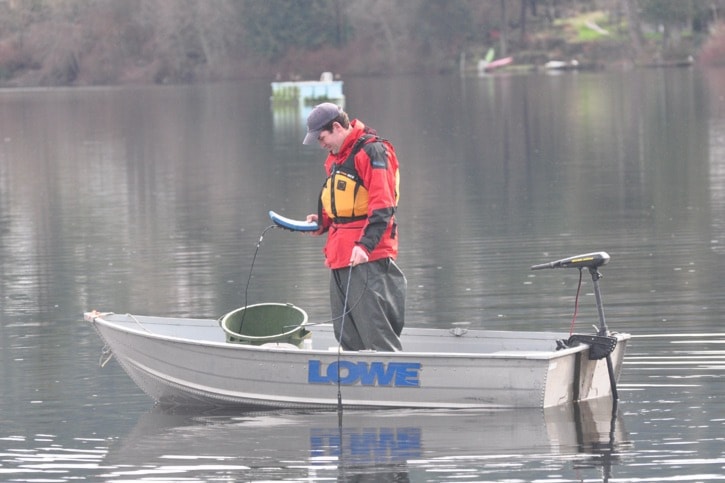For nearly 30 years, the white-capped aerator on Langford Lake has faithfully helped keep the popular fishing hole algae free.
But the little machine-that-could neither sucks nor blows as well as it use to. Past its mechanical prime, the provincial government is looking to replace the air pump, a project that could prove expensive.
Scott Silvestri, a small lakes fisheries biologist with the Ministry of Natural Resource Operations, is taking oxygen and temperature readings weekly at the lake, which he suspects isn’t being fed enough oxygen to keep water layer near the lake bed healthy.
“From the data I’ve collected, the aerator showing that it’s not able to keep up with demand (for oxygen),” Silvestri said “It’s a result of being old and worn out. The aerator is 30 years old without a retrofit. It’s time is up.”
Aerators were installed in Langford and Glen lakes around 1984 to compensate for decades of fertilizer and pollutant runoff from agriculture and development. The lakes are infused with an overload of nutrients, especially phosphorous.
Phosphorous consumes oxygen on the lake bed, creating an anoxic (low oxygen) layer, which is compensated for with the aerator. Without air pumped in, the lakes would eventually see large algae blooms in the peak of summer.
“The first cloudy day would kill the algae, which then would consume all the oxygen,” Silvestri said. “Then the entire lake could become anoxic, and you could get a fish kill. It would be harder on the fish than anything else.”
Glen Lake’s aerator was upgraded in 2005 and is helping keep the lake healthy. Silvestri expects after collecting data this year, the ministry will be able to calculate the aerator size to keep up with oxygen consumption.
A Langford parks staff report estimates an new system at $100,000, although Silvestri said it remains unclear what the final cost will be. The Habitat Conservation Trust Foundation currently pays for annual maintenance and costs of the aerator systems.
When it comes to paying for a new aeration system, Silvestri said it would likely be a partnership between Langford, the foundation and the province.
“Once we have an estimate whether the existing system is working as designed – at this point it looks like it’s not – then we can do a cost estimate.”
editor@goldstreamgazette.com
